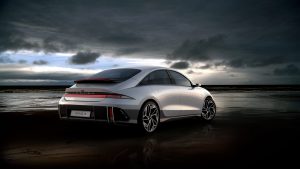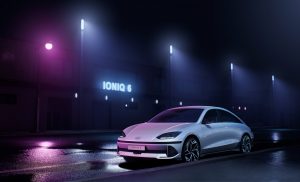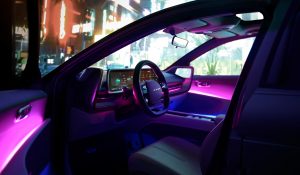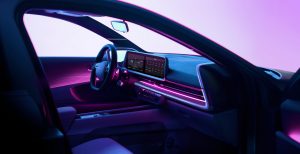Hyundai Unveils Much-Awaited EV, IONIQ-6
The word “Ioniq “is not new for you because it was a Hyundai’s Hybrid/ Plugin Hybrid / EV model. If you remember, Hyundai Nishat also introduced it as CBU/ Import in Pakistan. The Ioniq model chapter is closed, and the original Ioniq will go out of production in July 2022. But there is going to be new one, Hyundai IONIQ-6.
What is Hyundai IONIQ?
Ioniq might be dead, but the IONIQ nameplate continues and will always remind us about the original model. Ioniq is a sub-brand of Hyundai and will basically deal in fully electric vehicles under its brand. As its first offering, the Ioniq-5 was revealed in production form based on the concept car “Hyundai 45”. Ioniq-5 is a mix of crossover hatchback with impressive space on the interior. You can read about it here > https://bit.ly/3ORkM1K. IONIQ-5 got worldwide praise, and that’s evident from winning three global awards.
Hyundai’s onslaught on battery electric vehicles didn’t stop and a 4-door sedan was in the works for a long time, and Hyundai global just released the production version and named it. “IONIQ-6”. Although 6 made an official public appearance yesterday, it somewhat appeared as a concept in 2020 called “PROPHECY’.
Influence of IONIQ-6
The production version does take a lot of influence from the concept, but Hyundai mentioned that Prophecy/ Ioniq-6 took a lot of inspiration from car model exterior designs from the early 1930s. Back in the 1930s, car companies and automobile engineers understood the importance of aerodynamics & started implementing the idea of making vehicles curvier and fluid through the air, making them faster and more efficient.
Although there were no sophisticated wind tunnels back then, but the idea and concept were functional and theoretically positive. The industry’s design concept was called “STREAMLINER,” and Hyundai used the concept and the tagline to market their new 6, “The Electrified Streamliner.”
Shape of Hyundai IONIQ-6
The curvy front, rear, and arched side profile tell that Ioniq-6 is very aerodynamic, and this is not only visually as it also has a drag coefficient of 0.21, which is one of the lowest for any currently in production vehicles. The exterior might look polarizing, and it’s typical for almost all currently in production Hyundai group vehicles, but the same was said for Ioniq-5.
Rear
On the rear, you might see a Porsche 911, especially in the spoiler at the rear glass level, which has an elongated integrated pixelated LED high mount stop lamp and the slim rear tail lights, which are again pixelated.
And the rear truck opens up like a hatch, unlike a conventional sedan, and seems hinged at the D pillar’s curvature. The rear bumper also gets vertical lights. Door handles are flushed within doors, and on the side profile, you see a smooth curvy panel without any evident pultruding lines. Some people might see the influence of a beetle on the roof lines. Ioniq-6 also gets digital camera-based side view mirrors.
Front
The sloppy bonnet on the front helps reduce drag, while LED headlights have pixelated DRLs. Being an electric car, there is no frontal air intake, but on the lower portion of the bumper, there are air inlets for cooling battery and components. These inlets have active shutters that are closed automatically when required. As per Hyundai, the model gets around 700 “parametric pixels” on the car’s exterior.
As of size, the Ioniq-6 has approx. 116.1 “of wheelbase, and all these spaces bring a lot of room to the interior. As a reference, the Hyundai Sonata has a wheelbase of 111.8”.
Interior
On the interior, Hyundai only shared images of the front passenger seats area and dashboard. Like Ioniq-5, The 6 gets similar dual 12″ HD screens, each for instrumental cluster and infotainment screen. It also carries a similar setup of HVAC control with slim air vents. On the edges of the dashboard on the driver and passenger side, curvy surfaces are going upwards, which are actually embedded with screens to display the side view mirror camera display.
The Ioniq-6 has a similar steering wheel to the Ioniq-5, but the steering wheel doesn’t have an “H” logo and instead 4 dots, which represent the letter H as per the morse code, and these dots light up as green when the car in on charging.
Central Console
The central console gets a bridge-type tray with enormous space, and all window and door controls are arranged on the central console. Hyundai promised a premium level of fit, finish, and materials on the interior. The 6 will have extensive ambient lighting & around 64 color options.
If you remember, in the case of Ioniq-5, the central console is moveable front to back, but here in 6, it is fixed and creates a dedicated driver and passenger space.The interior is unique like Ioniq-5. Hyundai used recycled and eco-friendly materials like plastic bottles, plant-based yarns, bio paints, and plant extracts in most parts to remain more sustainable.
Technical Details
Hyundai didn’t share any technical details, but like Ioniq-5 or KIA EV6, the sedan will be based on Hyundai’s E-GMP/ Electric-Global Modular Platform. We can expect Ioniq-6 will be available both with RWD or AWD variants & possibly with 58-kWh or 77.4-kWh battery packs similar to Ioniq-5 or KIA EV6. Depending on the battery pack and motor configuration, the model might have 167hp & estimated range of around 350 kilometers plus for the basic RWD version with a 58kWh battery as seen on the Ioniq-5.
Expected Battery Power
We can expect a 321HP AWD variant with a 77.4 kWh battery with approx. 400 plus kilometer range similar to Ioniq-5. An RWD with a larger 77.4kWh battery making 225hp, we can expect around 500 kilometers of range. We can also expect a more potent 577HP Ioniq-6N in the future, a similar powertrain is available for KIA EV6 GT, and a similar setup is already in the works for Ioniq-5N and will be released soon.
Again we need to wait for exact technical details with battery and motor options. The battery packs will be capable of 400V AND 800V fast charging. Like Ioniq-5, it will use a 350kWh DC fast charger, and it can charge 10 to 80% in 18 minutes. We can expect the vehicle to come with V2L, a vehicle to load function/ capabilities that basically provide 3.6Kw of AC power.
Safety
The Hyundai IONIQ-6 will also come with Hyundai’s next generation of the active safety system, Highway Driving Assist 2, which comprises forward collision warning, pedestrian detection, dynamic cruise control, driver attention warning, intelligent speed limit, blind spots monitoring, and a lot more including a level 2 autonomous driving.
Expected Price
Hyundai will reveal full specifications of Hyundai IONIQ-6 in the next few weeks. Ioniq-6 will go into production in 2023 as the model year 2024 and possibly will start at around $45,000 for the base model before any tax incentives in the United States. Hyundai will target Korea, Europe, China, and North America as their main destinations.






